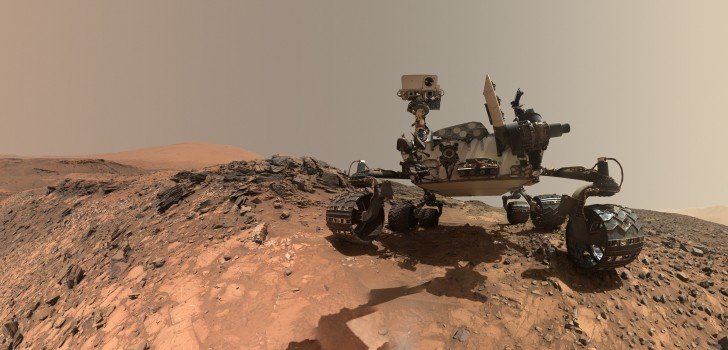The Mars exploring, miniature laboratory known as the Curiosity rover landed on Mars in 2012 and has been working hard ever since collecting samples and taking selfies to send back to NASA engineers.
Earlier this month, Curiosity took another magnificent selfie at a different angle than previous photographs and gives us another perspective of the rover that hasn’t been seen before. The image shows us just how much the rover has aged in the past few years and it also shows that a small rock has lodged in the left middle wheel – an annoyance for sure, but not something that should affect the overall operation of the machine.
The selfie was snapped on August 5th at “Buckskin” at the Marias Pass site located in the foothills of the 3 ½ mile-high Mount Sharp. NASA released the image this week. The vehicle was able to shoot several low-angle photographs because of the slant of the terrain, thus giving us a new look at the machine.
The rover takes its selfies like most people do – holding the camera out in front of it and snapping away. Specifically, Curiosity is equipped with a Hand Lens Imager known as MAHLI. It snaps several shots and then NASA engineers piece the images together to produce the final image released to the public.
In final form, the photograph gives the illusion that the rover set up its own tripod and set a timer.
The rover’s work at Buckskin was the first full-on drilling operation to take place since February, when a short circuit was observed in the drill’s hammer. Steven Lee, deputy project manager for Curiosity at NASA’s Jet Propulsion Laboratory stated that, “[NASA was] pleased to see no repeat of the short circuit during the Buckskin drilling and sample transfer.”
The Buckskin and Mount Sharp areas are of great interest to scientists as evidence from the areas indicate there was water present several billion years ago.
The dirt and rock deposits show that flowing water must have fed the lake that is now a deep crevice on the surface of Mars. Scientists speculate that conditions on Mars at that time could very probably have allowed bacterial and other microbial life to thrive – if it ever existed – on Mars.
Igor Mitrofanov of the Space Research Institute in Moscow stated that, “The ground about one [yard] beneath the rover in [the Buckskin] area holds three or four times as much water as the ground anywhere else Curiosity has driven during its three years on Mars.”
Up next for Curiosity is a trip southwest, where it will continue to collect samples and take pictures. Since the rover landed on Mars in 2012, it has travelled 6.9 miles.
As it continues to climb Mount Sharp, Curiosity should find evidence of the planet’s drying since Mars is now barren and cold. Scientists want to understand how Mars went from a “wet planet” to what it is today.
Stay Connected